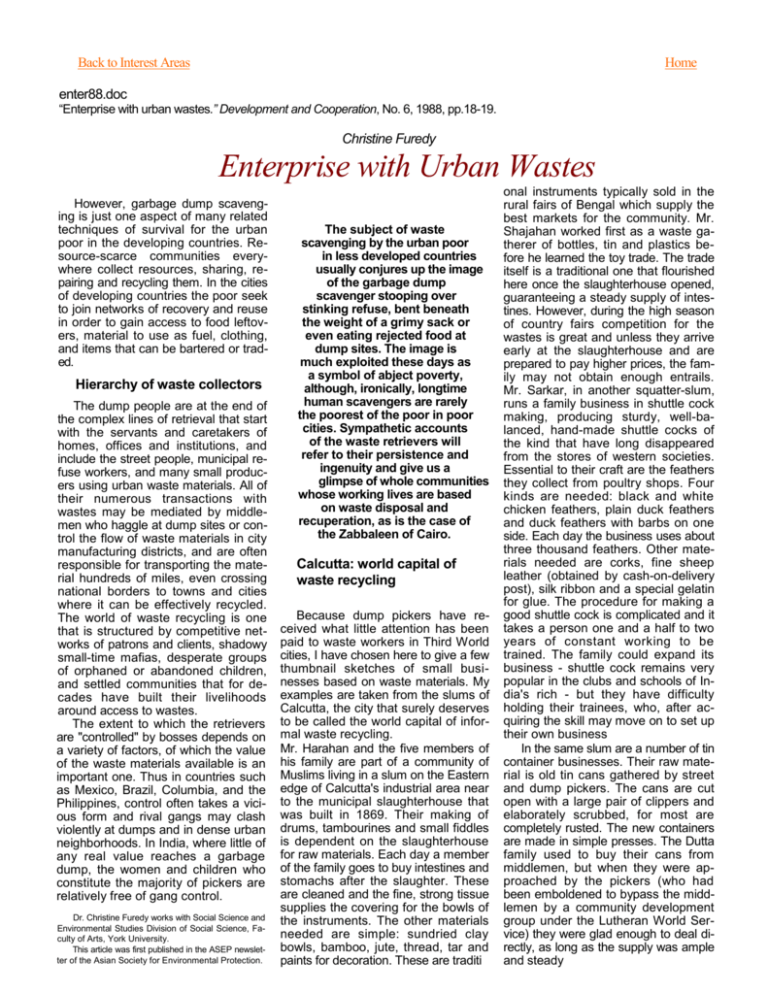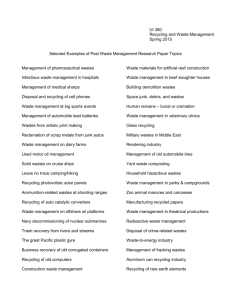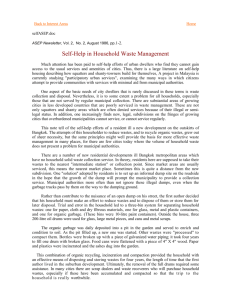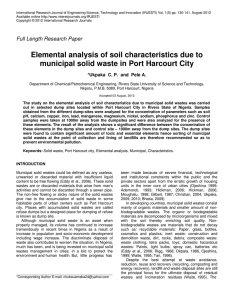Enterprise with Urban Wastes.
advertisement

Back to Interest Areas Home enter88.doc “Enterprise with urban wastes.” Development and Cooperation, No. 6, 1988, pp.18-19. Christine Furedy Enterprise with Urban Wastes However, garbage dump scavenging is just one aspect of many related techniques of survival for the urban poor in the developing countries. Resource-scarce communities everywhere collect resources, sharing, repairing and recycling them. In the cities of developing countries the poor seek to join networks of recovery and reuse in order to gain access to food leftovers, material to use as fuel, clothing, and items that can be bartered or traded. Hierarchy of waste collectors The dump people are at the end of the complex lines of retrieval that start with the servants and caretakers of homes, offices and institutions, and include the street people, municipal refuse workers, and many small producers using urban waste materials. All of their numerous transactions with wastes may be mediated by middlemen who haggle at dump sites or control the flow of waste materials in city manufacturing districts, and are often responsible for transporting the material hundreds of miles, even crossing national borders to towns and cities where it can be effectively recycled. The world of waste recycling is one that is structured by competitive networks of patrons and clients, shadowy small-time mafias, desperate groups of orphaned or abandoned children, and settled communities that for decades have built their livelihoods around access to wastes. The extent to which the retrievers are "controlled" by bosses depends on a variety of factors, of which the value of the waste materials available is an important one. Thus in countries such as Mexico, Brazil, Columbia, and the Philippines, control often takes a vicious form and rival gangs may clash violently at dumps and in dense urban neighborhoods. In India, where little of any real value reaches a garbage dump, the women and children who constitute the majority of pickers are relatively free of gang control. Dr. Christine Furedy works with Social Science and Environmental Studies Division of Social Science, Faculty of Arts, York University. This article was first published in the ASEP newsletter of the Asian Society for Environmental Protection. The subject of waste scavenging by the urban poor in less developed countries usually conjures up the image of the garbage dump scavenger stooping over stinking refuse, bent beneath the weight of a grimy sack or even eating rejected food at dump sites. The image is much exploited these days as a symbol of abject poverty, although, ironically, longtime human scavengers are rarely the poorest of the poor in poor cities. Sympathetic accounts of the waste retrievers will refer to their persistence and ingenuity and give us a glimpse of whole communities whose working lives are based on waste disposal and recuperation, as is the case of the Zabbaleen of Cairo. Calcutta: world capital of waste recycling Because dump pickers have received what little attention has been paid to waste workers in Third World cities, I have chosen here to give a few thumbnail sketches of small businesses based on waste materials. My examples are taken from the slums of Calcutta, the city that surely deserves to be called the world capital of informal waste recycling. Mr. Harahan and the five members of his family are part of a community of Muslims living in a slum on the Eastern edge of Calcutta's industrial area near to the municipal slaughterhouse that was built in 1869. Their making of drums, tambourines and small fiddles is dependent on the slaughterhouse for raw materials. Each day a member of the family goes to buy intestines and stomachs after the slaughter. These are cleaned and the fine, strong tissue supplies the covering for the bowls of the instruments. The other materials needed are simple: sundried clay bowls, bamboo, jute, thread, tar and paints for decoration. These are traditi onal instruments typically sold in the rural fairs of Bengal which supply the best markets for the community. Mr. Shajahan worked first as a waste gatherer of bottles, tin and plastics before he learned the toy trade. The trade itself is a traditional one that flourished here once the slaughterhouse opened, guaranteeing a steady supply of intestines. However, during the high season of country fairs competition for the wastes is great and unless they arrive early at the slaughterhouse and are prepared to pay higher prices, the family may not obtain enough entrails. Mr. Sarkar, in another squatter-slum, runs a family business in shuttle cock making, producing sturdy, well-balanced, hand-made shuttle cocks of the kind that have long disappeared from the stores of western societies. Essential to their craft are the feathers they collect from poultry shops. Four kinds are needed: black and white chicken feathers, plain duck feathers and duck feathers with barbs on one side. Each day the business uses about three thousand feathers. Other materials needed are corks, fine sheep leather (obtained by cash-on-delivery post), silk ribbon and a special gelatin for glue. The procedure for making a good shuttle cock is complicated and it takes a person one and a half to two years of constant working to be trained. The family could expand its business - shuttle cock remains very popular in the clubs and schools of India's rich - but they have difficulty holding their trainees, who, after acquiring the skill may move on to set up their own business In the same slum are a number of tin container businesses. Their raw material is old tin cans gathered by street and dump pickers. The cans are cut open with a large pair of clippers and elaborately scrubbed, for most are completely rusted. The new containers are made in simple presses. The Dutta family used to buy their cans from middlemen, but when they were approached by the pickers (who had been emboldened to bypass the middlemen by a community development group under the Lutheran World Service) they were glad enough to deal directly, as long as the supply was ample and steady Enterprise with urban wastes cont… Aid for waste retrievers The examples cited here could be multiplied many times to include those who supply basic needs for fuel by making fuel balls of dung and coal dust, to those who work as subcontractors for large corporations, such as families making parts of bicycle seats from scrap leather. Each one of the small enterprises that use the city's waste materials can tell of the struggle to survive at the margins of a highly competitive economy. Every family member gives almost every available hour to the work, which is often carried out in a squatter-built shack filled with the noise, the dust and the smell of the activity. Frequently there are crises related to supplies, financing, meeting debts, finding and retaining markets. In spite of the struggle, these small-scale entrepreneurs are determined folk. In most cases, they could greatly benefit from some modest modern equipment and better knowledge of the market. But bank loans are rarely given to small operators unless an NGO intercedes and helps them to meet the puzzling bureaucratic requirements of whatever programs may exist to encourage small enterprises. When successful in obtaining small loans, few slum producers are known to default. The waste recyclers cling doggedly to their niches in the urban economy, stigmatized because they handle wastes, and generally overlooked by economists, sociologists and city planners. Awareness of scarce resources and mounting pollution problems has led to world-wide interest in waste recovery and recycling in the past decade. But most of the national and international programs to promote waste recovery in developing countries are formulated without detailed knowledge of how re covered materials are used producti vely by the poor in urban centers. Funds are directed to municipal and private corporate schemes. Most of what little aid may go to small operators comes from perceptive NGOs working in slums. The aid is fitful and inadequate, for those organizations have to meet many more urgent demands for assistance. Perhaps official neglect will change if we can learn more about the waste workers of Third World cities.






